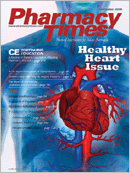Publication
Article
Pharmacy Times
The Role of the Pharmacist in Screening for CVD Risk
Author(s):
According to the American HeartAssociation, cardiovascular disease(CVD) affects 71,300,000individuals—1 of every 3 individuals in theUnited States.1 CVD continues to be theleading cause of death among both menand women.1,2 It is estimated that every26 seconds an individual in America willhave a coronary event, and approximatelyonce every minute an individual will diefrom a coronary event.1 Furthermore, it isestimated that ~40% of individuals whoexperience a coronary attack will diewithin a year of the event.1
CVD is the leading cause of deathamong women over 65 years of age, andit is estimated that 1 in 5 women havesome degree of the disease.1-3 There is agrowing occurrence of CVD in youngerwomen as well; the disease is the thirdleading cause of death among womenaged 25 to 44 years and the second leadingcause of death among women aged45 to 64 years.4
Empowering Patients
These alarming statistics should motivatehealth care professionals to empowertheir patients with knowledgeabout CVD and the risk factors associatedwith it, as well as measures to reduceand/or prevent its occurrence.
As among the most accessible andtrusted health care professionals, pharmacistscan be a fundamental source ofinformation for individuals with regard toCVD. By evaluating patient medicationprofiles and medical history, pharmacistscan identify those patients who may beat an increased risk for developing thedisease. Certain risk factors may predisposean individual to developing CVD.These risk factors can be nonmodifiableor modifiable (Table).
Medication Counseling
By evaluating a patient's drug profile,the pharmacist can look for potentialdrug interactions and appropriate dosageregimens. Through the interventionsof pharmacists, clinical recommendationscan be made to physicians aboutother possible pharmacologic agentsthat may be prescribed as well, if necessary.In addition, a patient's response tomedication therapy can be evaluated foroptimal therapeutic benefit.
In order to combat the serious consequencesof CVD, individuals should bemade aware of the signs and symptomsof the disease. Effective and thoroughmedication counseling should includeinstructions on proper drug administrationand cautions about adverse effects.
Decreasing Risks
Patients also should be educatedabout the various means of decreasingtheir CV risks, such as routinely monitoringblood pressure and cholesterol levelsand obtaining regular medical care.Additionally, counseling should includean emphasis on the importance of adheringto the prescribed treatment plan,especially medication compliance, andadvice on lifestyle changes, such as dietand exercise.
By following these recommendations,patients are empowered to take a proactiverole in their CV health and thereby tooptimize their outcomes. Pharmacistsalso can encourage patients to discussany concerns about their CV risks withtheir primary health care provider.
Ms. Terrie is a clinical pharmacy writerbased in Haymarket,Va.
For a list of references, send a stamped,self-addressed envelope to: ReferencesDepartment, Attn. A. Rybovic, PharmacyTimes, Ascend Media Healthcare, 103 CollegeRoad East, Princeton, NJ 08540; or send ane-mail request to: [email protected].







